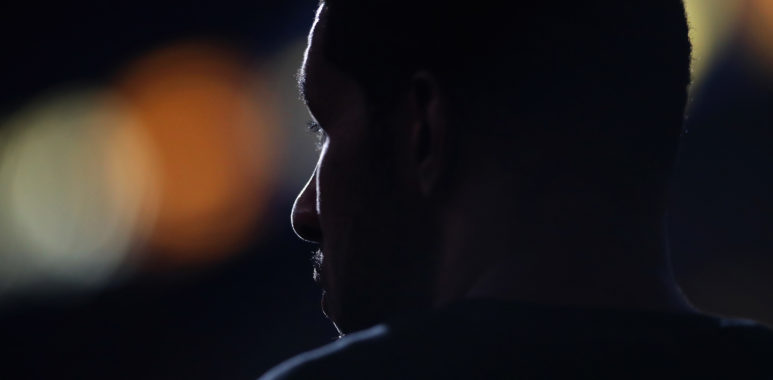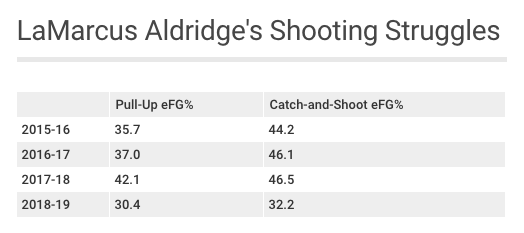
What’s Wrong With LaMarcus Aldridge on Offense?
The San Antonio Spurs are 7-7. They’ve won some games they shouldn’t have won, and they’ve lost some games they shouldn’t have lost. Overall, they looked very mediocre, which isn’t surprising given their roster.
But one key Spurs performer has been performing quite a bit below his standards. LaMarcus Aldridge is averaging 24 points per 100 possessions, which is the lowest mark since his rookie year. His true-shooting percentage of 46.7 is much lower than it has ever been, even in an NBA where offenses are more efficient than they’ve been since at least 1973-74.
Overall, he’s been a negative contributor for the Spurs, mainly on the offensive end of the floor. Let’s dive into his performance there.
What He is Doing Well
Aldridge has played in lineups with one other big man for most of his career. Joel Przybilla, Marcus Camby, Robin Lopez and Tim Duncan have helped him by rebounding and patrolling the paint on defense.
Last year, Aldridge started to get more minutes as the only big on the floor. Pau Gasol sometimes joined him, but Gregg Popovich staggered their minutes more later in the season.
So far in 2018-19, Aldridge has almost always been the Spurs’ only true big man on the floor. He’s responded by doing a great job cleaning the glass. The 33-year-old is averaging a career-high 15.2 rebounds per 100 possessions. His 5.3 offensive boards per 100 possessions is just a tick below his career best of 5.4. Among the league’s top 40 per-game rebounders, only Anthony Davis (48.4) has a higher contested rebounding percentage than Aldridge (44.2).
On defense, Aldridge has been OK as a primary rim protector and back-line communicator. He was really solid last year, but his Defensive PIPM has dipped from 0.7 to negative-0.2. It’s hard to tell how much of this is because of several defensively-challenged teammates.
His Jumper Isn’t Falling
Aldridge is known for shooting a lot of midrange jumpers, and making a decent percentage of them. He’s scored countless points in his career from pick-and-pops and his trademark high-release fadeaway.
Neither of those shots is falling this year.

Overall, those two shots each yielding just above 0.6 points per possession represent 49.3 of his total field-goal attempts. That’s just not acceptable for any NBA rotation player, much less a star.
The catch-and-shoot numbers aren’t helped by the fact that he’s missed all six of his three-point attempts. Through 14 games last season, he was 9-of-26 from downtown.
The pull-up numbers are largely based on rhythm. Opponents contest Aldridge’s fadeaway pretty well almost every time he shoots it, but it goes in more often if his other shots in the game are also falling. That hasn’t been the case this year.
His effective field-goal percentage on his 51 jumpers labeled “open” (when a defender is four to six feet away) is just 27.5. There has to be something psychological going on there.
He’s Not Finishing Well Inside
Aldridge has a thick frame, long arms and a soft touch around the basket. He’s shot above 70 percent inside of three feet in each of the last four seasons. But this season, he’s all the way down to 63.1 percent, easily a career low.
Patience is the main issue for Aldridge this season. Last year, when he got position from point-blank range, he knew when to use up fakes or step-throughs to free himself up for high-percentage finishes or shooting fouls.
This year, he’s rushing things and attempting more difficult layups. In particular, he’s trying a lot of tip-ins when it would just be wiser to grab the rebound with two hands. Check out some of those tip attempts and other missed opportunities inside the restricted area this season:
He Isn’t Taking Care of the Ball Well
Aldridge normally has strong and dependable hands. On a per-100 possession basis, though, he’s turning the ball over 2.9 times this season, which is a career high.
After his fantastic year in 2017-18, teams are sending plenty of double teams at Aldridge when he gets good position in the post. LMA is having trouble making some reads and fumbling the ball frequently in those situations.
This is probably the least of his concerns right now, but it’s still worth noting.
What Adjustments Can He Make?
Besides offensive rebounding, Aldridge has struggled in every other offensive area.
Some of the issues are just due to bad luck. For example, the open jumpers that are rimming out will probably start to fall more at some point.
But he also needs to make some changes to his approach.
Unlike last season, Aldridge is not the Spurs’ No. 1 option. He got really comfortable in that role and thrived in it a year ago, but DeMar DeRozan is the better offensive player. NBA offenses nowadays have much more success relying on perimeter creation rather than post play. Aldridge has gotten and will continue to get more of his shots on passes from teammates than he’s used to. He needs to embrace that.
LMA also has a size and strength advantage on a lot of his defenders in a league where the big men aren’t as big anymore. Why should he settle for post position 15 feet away from the hoop just to fade away for a contested 16-foot jumper? Aldridge has to be aggressive in sealing his man closer to the basket, especially when there is a clear mismatch.
Once he establishes his physicality inside using patient moves and strong hands, good things happen for the Spurs. Opposing teams rack up fouls and he commands even more help defense than normal.
And when Aldridge is a ball-screener, he should have two primary options, in this order: roll to the hoop or pop out for a three-pointer.
Aldridge said he practiced his three-point shot over the summer and was planning to use it more, per the San Antonio Express-News’ Jeff McDonald. For some reason, he isn’t taking them.
Veteran big men like Al Horford, Marc Gasol and Brook Lopez all switched from the midrange jumper to threes well into their careers with great success. Why hasn’t Aldridge made a similar move? He doesn’t have to abandon the pick-and-pop midrange shot, but it shouldn’t be such a major staple of his game, especially when it’s not working.
LaMarcus doesn’t even have to be amazing from behind the arc for it to be a worthwhile move. In his Spurs tenure, he’s 45.1 percent on catch-and-shoot two-pointers. If he becomes even a 30 percent three-point shooter off the catch (which is pretty bad), it’s worth it for the spacing help it provides.
But really, priority No. 1 is gaining confidence by using his frame and touch to dominate inside. Once he gets going there, he can start to move outside. And preferably, “outside” can mean more than just the midrange.
Note: All stats are from NBA.com or Basketball-Reference.com. Footage used is taken from 3ball.io.
Photo by Christian Petersen/Getty Images
